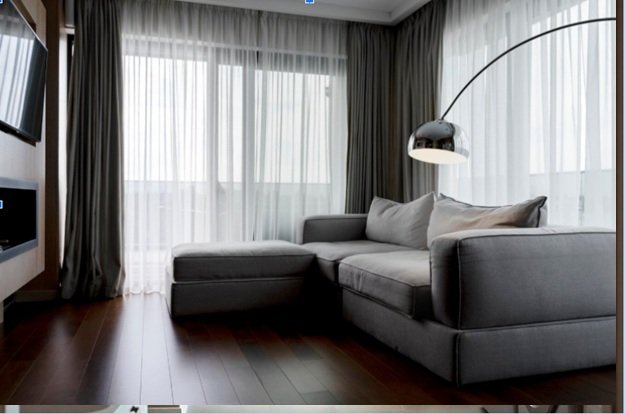
Moving into a new home is like stepping into a blank canvas that’s all yours to paint on. You’re excited, slightly overwhelmed, and determined not to ruin it.
Whether it’s your first house or a fresh start, those empty walls and awkward corners can feel intimidating. But with the right home design tips, you can make any space feel spacious, open, and totally personalised to you.
Let’s talk about easy but high-impact designs for your new living space that make it truly feel like yours.
Natural light does things that artificial light can’t. From making you feel awake and alive to decorating a room with picturesque rays, the light from outside works way better than bulbs and fixtures you install inside.
If your space is feeling boxed in or you don’t like harsh sunrays, sheer curtains can help. They soften incoming light without blocking it entirely, giving your room that brightness and privacy needed.
These curtains also tend to blend in with almost all kinds of aesthetics. Opt for soft whites, warm neutrals, or even dusty pastels for a subtle, refined finish.
Beyond aesthetics, sheer curtains help regulate the mood of a room. They make a home feel lived-in, but not cluttered – like you’ve thought about comfort and calm just as much as looks.
There’s a fine line between personalisation and over-decorating with impulse purchases. Instead of cluttering every shelf, go for intentional personal pieces.
Maybe you can get an artsy sculpture that caught your eye at a thrift store, frame lyrics from your favourite song, or design a tiny gallery wall of your paintings.
Such details tell a story without making it look overboard.
If you’re not sure what your personal style is yet, just go with what makes you smile. You can always edit later.
The monochrome aesthetic isn’t everyone’s style. Don’t be scared of adding colour where you want it. The beauty of buying your first home is that you can make changes as you like.
Colour can make your space feel bigger, cosier, warmer, or cooler, depending on what you’re going with. Paint your walls to match the furniture. Add accent pieces with vibrant colours for a bursting effect.
Warm tones like terracotta, mustard, or blush can make a room feel cosy and grounded, while cool tones like sage, sky blue, or soft grey create calm, airy spaces.
Want your home to feel bigger? Pale tones reflect more light, making rooms feel open and expansive. Darker colours can add intimacy to small rooms like studies or reading nooks.
If you’re nervous, start small. Try small pillows, rugs, or art pieces first. You can also use colour to subtly zone different areas in an open-plan space — for example, a rich feature wall to define your lounge area, or a soft pastel backdrop to set apart a dining nook.
Accent pieces like cushions, throws, or vases are a great way to experiment, and if you’re still unsure, paint swatches or removable wallpaper give you flexibility without the long-term commitment.
Keeping a space roomy doesn’t mean it has to have no furniture. It just means choosing pieces that don’t visually block off areas.
Transparent items, such as acrylic chairs or glass tables, and elevated furniture with legs can help create the illusion of space. Also, smart storage items and minimalist pieces may contribute to making a room feel spacious.
Another option is mirrors. You can place them across from windows to bounce light around, or in small rooms to make them feel less boxed in and a little more artistic.
To take it a step further, think about how you arrange your furniture. Keep windows clear of bulky pieces and consider swapping dark, heavy drapes for lighter fabric alternatives. If your space still feels dim, place a mirror directly across from a window to bounce natural light around the room.
This is a well-known trick to brighten up even the darkest corners.
Plants are the one thing people get when they don’t know how to decorate their space or have an aesthetic yet. They actually do their job of making it seem like you know what you’re doing.
Plants bring life, colour, and a sense of calm into your home. And this applies to both interior and exterior design. If you’re someone who can’t or doesn’t want to carry the responsibility of keeping these green beings alive, there are low-maintenance indoor options as well.
Design isn’t limited to the tangible elements only. When you walk into a place, how it smells affects how you think about it. Imagine stepping into a house that has the fanciest interior but smells like an old, unwashed rag. All aesthetics go out the window.
Get candles, diffusers, or incense to avoid this. Just don’t overdo it.
Designing your new home can feel stressful and expensive. It doesn’t have to be. In fact, it’s just a series of choices: ones that work for you and your lifestyle, that speak to who you are, and that make you feel good.
Letting in more light, layering on textures, picking colours you love, or placing a plant in just the right spot – it all adds up. Designing a home isn’t about doing it perfectly. It’s about doing it for you — creating a space that feels open, inviting, and unmistakably you.
Take your time, trust your instincts, and just know: you don’t have to get it right all at once. You can evolve, and so can your home.
Unlock a Brighter Future: Why Solar Power is a Smart Investment
September 29, 2025Unlocking the Best Real Estate Investment Opportunities
September 26, 20257 Aircon Cleaning Tips Every Homeowner Should Know
September 22, 2025Finding Reliable Tenants with Top Property Management in Brisbane
September 9, 2025The Importance of Regular Electrical Safety Inspections
September 9, 2025